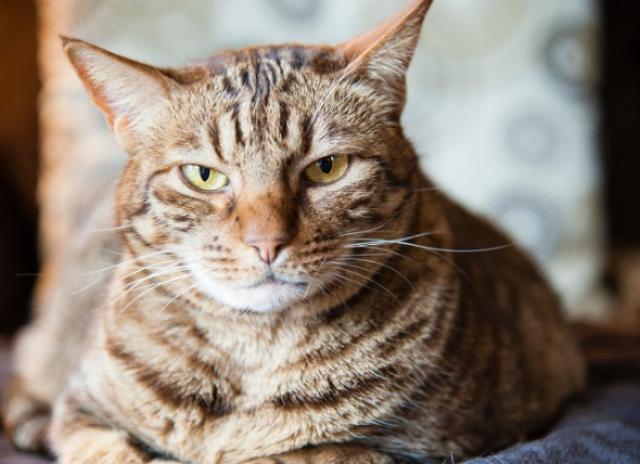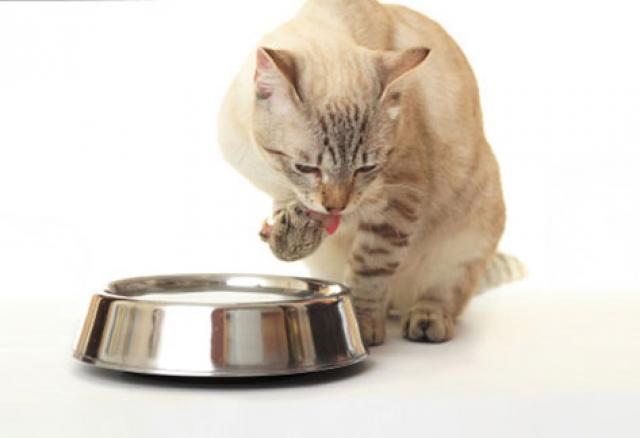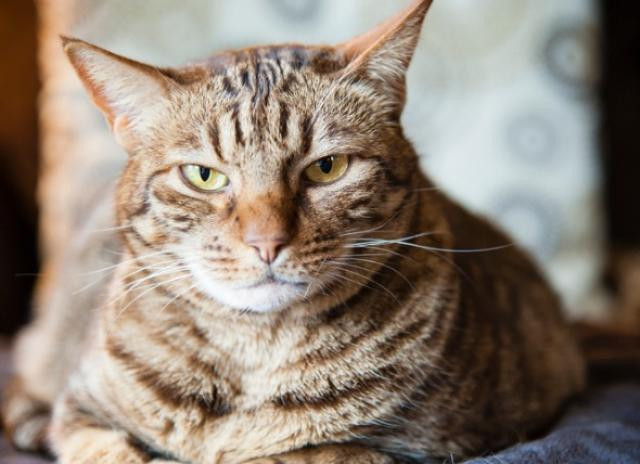“What Does It Mean When A Cat Stares At You?” It’s a question many cat owners ponder. A cat’s gaze can convey a multitude of messages, from affection to hunger. At solcat.net, we help you understand your feline friend’s behavior, ensuring a harmonious relationship built on understanding and trust. Delve into the world of feline communication and discover the hidden meanings behind those captivating stares. Learn about cat body language, feline behavior, and cat communication.
1. Decoding the Feline Gaze: Why Cats Stare
If your cat is staring at you, there are several reasons for this behavior. Understanding the context and other body language cues is key to deciphering the message.
1.1. Seeking Your Attention
Is your cat seeking your attention? Often, a cat’s stare is simply a way to get your attention. Once they have it, they may slow blink, meow, rub against you, or even roll over. This is their way of saying, “Hey, notice me!”
- Action: If your cat is staring at you for attention, respond by petting them, talking to them, or engaging in a gentle play session.
1.2. Invitation to Playtime
A playful stare is often accompanied by specific body language. Does your cat crouch low, with dilated pupils and a swishing tail? They might be ready to pounce and play. Sometimes, they may even sprint toward you and swat at your feet.
According to a study published in the Journal of Veterinary Behavior, playful aggression is a common behavior in young cats, often directed at their owners’ feet or ankles.
 Cat staring intently, ready to play
Cat staring intently, ready to play
- Action: Grab a cat wand or another interactive toy and engage in a fun play session. This will help them burn energy and strengthen your bond.
1.3. Requesting a Meal
Is it feeding time? Some cats are very punctual when it comes to meals. They might stare at you intently, especially around their usual feeding time. Once you make eye contact, they may vocalize and rub against you, leading you to their food bowl or the location where their food is stored.
 Cat staring at owner, indicating hunger
Cat staring at owner, indicating hunger
- Action: If it’s time for their meal, fill their food bowl and give them a nutritious meal. If they are staring while you are eating, resist the urge to give them table scraps, as human food can be harmful to cats.
1.4. Expressing Fear or Anxiety
A fearful stare is different from an affectionate or playful one. Look for other signs of fear and anxiety in your cat’s body language, such as:
- Dilated pupils
- Lowered head
- Ears pulled back or to the side
- Crouched body
- Raised fur (piloerection)
The cat is staring to keep an eye on the source of their fear. This could be a loud noise, a strange object, or even a person they don’t trust.
According to research from the Cornell Feline Health Center, cats often exhibit fear-related behaviors when exposed to unfamiliar environments or stimuli.
- Action: Identify the source of the fear and try to remove it or create a safe space for your cat to retreat to. Avoid forcing them to confront the source of their fear.
1.5. Displaying Affection
Cats can show affection by making eye contact with you and performing slow blinks. This is often referred to as a “cat kiss.” The act of making eye contact and voluntarily blinking indicates trust and comfort. They feel safe enough to close their eyes in your presence.
 Cat slow blinking at owner, showing affection
Cat slow blinking at owner, showing affection
- Action: If your cat slow blinks at you, return the gesture by slow blinking back. This reinforces the bond between you and your cat.
1.6. Signaling Aggression
An aggressive stare is hard and unblinking, often paired with stiff body language and raised fur along the back and tail. This is a clear warning sign. The cat is communicating that they need space and will confront you if you don’t back off.
- Action: Avoid direct eye contact, keep still, and slowly back away to give the cat more space. Do not attempt to approach, talk to, or pet the cat.
2. Interpreting Cat Body Language: A Comprehensive Guide
Understanding cat body language is crucial for interpreting their stares. Here’s a comprehensive guide to help you decipher what your cat is trying to tell you.
2.1. Tail Position
A cat’s tail can communicate a wide range of emotions.
| Tail Position | Meaning |
|---|---|
| Upright | Happy, confident, and approachable |
| Down | Fearful, anxious, or submissive |
| Swishing | Agitated, irritated, or playful |
| Puffed Up | Fearful or aggressive |
| Tucked Between Legs | Scared or insecure |
According to the American Animal Hospital Association (AAHA), understanding tail positions can provide valuable insights into a cat’s emotional state.
2.2. Ear Position
The position of a cat’s ears can also provide clues about their mood.
| Ear Position | Meaning |
|---|---|
| Forward | Alert, interested, or happy |
| Back | Fearful, anxious, or defensive |
| Sideways | Irritated or unsure |
| Flattened | Aggressive or very scared |
2.3. Pupil Dilation
The size of a cat’s pupils can indicate their emotional state.
| Pupil Size | Meaning |
|---|---|
| Dilated | Excited, fearful, or playful |
| Contracted | Relaxed, content, or aggressive (in bright light) |
2.4. Vocalizations
Cats use a variety of vocalizations to communicate, including meows, purrs, hisses, and growls.
| Vocalization | Meaning |
|---|---|
| Meow | Greeting, attention-seeking, or demand |
| Purr | Contentment or self-soothing |
| Hiss | Fear, aggression, or warning |
| Growl | Aggression or warning |
3. The Science Behind Cat Stares: Research and Studies
Several studies have explored the science behind cat stares and feline communication. These studies provide valuable insights into why cats behave the way they do.
3.1. Feline Facial Expressions
Research has shown that cats have a wide range of facial expressions that they use to communicate with each other and with humans. These expressions can convey emotions such as happiness, fear, and aggression.
A study published in the journal “Behavioural Processes” found that cats use at least 276 distinct facial expressions.
3.2. The Role of Oxytocin
Oxytocin, often referred to as the “love hormone,” plays a role in the bond between cats and their owners. When a cat stares at you and slow blinks, it can trigger the release of oxytocin in both you and your cat, strengthening your bond.
According to research from the University of Lincoln, interacting with cats can increase oxytocin levels in humans, similar to the effects of interacting with dogs or other pets.
3.3. Understanding Feline Cognition
Studies on feline cognition have shown that cats are intelligent and capable of complex thought processes. They can recognize their owners, understand routines, and even learn to perform tricks. Their stares are often a reflection of their cognitive abilities and their attempts to communicate with us.
4. How to Respond to Your Cat’s Stares: A Practical Guide
Knowing how to respond to your cat’s stares is essential for maintaining a healthy relationship. Here’s a practical guide to help you navigate different situations.
4.1. When Your Cat Wants Attention
If your cat is staring at you and exhibiting attention-seeking behaviors like meowing or rubbing against you, give them the attention they crave. Pet them, talk to them, or engage in a gentle play session.
4.2. When Your Cat is Hungry
If it’s feeding time and your cat is staring at you, fill their food bowl with a nutritious meal. Avoid giving them table scraps, as human food can be harmful to cats.
4.3. When Your Cat is Scared
If your cat is staring at something out of fear, identify the source of the fear and try to remove it. Create a safe space for your cat to retreat to, and avoid forcing them to confront their fear.
4.4. When Your Cat is Affectionate
If your cat is staring at you and slow blinking, return the gesture by slow blinking back. This reinforces the bond between you and your cat.
4.5. When Your Cat is Aggressive
If your cat is giving you a hard, unblinking stare paired with stiff body language, avoid direct eye contact and slowly back away to give them more space. Do not attempt to approach, talk to, or pet the cat.
5. Common Misconceptions About Cat Stares: Debunking Myths
There are several misconceptions about cat stares. Let’s debunk some of the most common myths.
5.1. Myth: Cats Stare to Intimidate
While cats can stare to signal aggression, this is not always the case. Often, a cat’s stare is simply a way to get your attention or communicate a need.
5.2. Myth: Staring Contests Show Dominance
Staring contests with your cat are not a good idea. Cats do not view staring as a game or a way to establish dominance. Instead, they may perceive it as a threat.
5.3. Myth: Cats Only Stare When They Want Something
Cats can stare for a variety of reasons, including affection, fear, or boredom. Staring is not always indicative of a need or desire.
6. Breeds and Staring Behavior: Are Some Cats More Stary Than Others?
Some cat breeds are known for being more vocal and expressive than others, which can include staring behavior.
6.1. Siamese
Siamese cats are known for being very vocal and attention-seeking. They often stare at their owners to communicate their needs and desires.
6.2. Persian
Persian cats are more independent, but they can still stare at their owners to show affection or request attention.
6.3. Maine Coon
Maine Coon cats are known for being gentle giants. They often stare at their owners to show affection and bond with them.
6.4. Abyssinian
Abyssinian cats are intelligent and curious. They may stare at their owners out of curiosity or to seek attention.
7. Medical Reasons for Staring: When to Consult a Vet
In some cases, excessive staring can be a sign of an underlying medical condition. If your cat is staring more than usual or exhibiting other unusual behaviors, it’s essential to consult a veterinarian.
7.1. Cognitive Dysfunction Syndrome (CDS)
CDS, also known as feline dementia, can cause cats to become disoriented and stare blankly into space. Other symptoms of CDS include confusion, changes in sleep patterns, and decreased interaction with owners.
7.2. Vision Problems
If your cat is experiencing vision problems, they may stare intently at objects or people to try to focus. Other signs of vision problems include bumping into objects, squinting, and excessive blinking.
7.3. Hyperthyroidism
Hyperthyroidism, a common condition in older cats, can cause increased activity levels and staring. Other symptoms of hyperthyroidism include weight loss, increased appetite, and increased thirst.
8. Environmental Factors and Staring: How Surroundings Play a Role
A cat’s environment can significantly influence its behavior, including staring. Changes in the environment, such as new furniture, guests, or loud noises, can cause a cat to stare more frequently.
8.1. New Environments
When a cat is introduced to a new environment, they may stare more often as they try to familiarize themselves with their surroundings. This is a normal behavior and should subside as the cat becomes more comfortable.
8.2. Stressful Situations
Stressful situations, such as vet visits or loud parties, can cause a cat to stare more frequently. Providing a safe and quiet space for the cat to retreat to can help alleviate their stress.
8.3. Boredom
Cats who are bored may stare at their owners or out the window as a way to entertain themselves. Providing plenty of toys and enrichment activities can help prevent boredom.
9. The Human-Cat Connection: Understanding Our Role in Staring Behavior
The relationship between humans and cats is complex and multifaceted. Our behavior can influence a cat’s staring behavior, and vice versa.
9.1. Reinforcing Staring
If you consistently respond to your cat’s stares by giving them attention or food, they will learn to stare more often. This is known as positive reinforcement.
9.2. Ignoring Staring
If you ignore your cat’s stares, they may eventually stop staring. However, it’s important to ensure that you are still meeting their needs for attention and food.
9.3. Communication Cues
Paying attention to your cat’s body language and vocalizations, in addition to their stares, can help you better understand their needs and desires.
10. Training and Staring: Can You Modify the Behavior?
While you can’t completely eliminate staring, you can modify the behavior through training and positive reinforcement.
10.1. Redirecting Attention
If your cat is staring at you excessively, try redirecting their attention to a toy or another activity. This can help break the staring habit.
10.2. Positive Reinforcement
Reward your cat for good behavior, such as playing quietly or relaxing in their bed. This can help reduce their reliance on staring to get your attention.
10.3. Consistency
Consistency is key when it comes to training. Be consistent with your responses to your cat’s stares, and they will eventually learn what behaviors are rewarded and what behaviors are not.
FAQ: Unlocking the Secrets Behind Feline Gazes
Here are some frequently asked questions about cat stares, with answers to help you better understand your feline friend.
1. Why does my cat stare at me while I sleep?
Your cat might be staring at you while you sleep out of curiosity, affection, or a need for attention. They could also be ensuring that you are safe and sound.
2. Is it rude to stare back at my cat?
Staring directly at a cat can be perceived as a threat. It’s best to avoid prolonged direct eye contact and instead use slow blinks to show affection.
3. Why does my cat stare at the wall?
Your cat may be staring at the wall because they see or hear something that you don’t, such as insects or rodents. It could also be a sign of a medical condition, so it’s best to consult a vet.
4. Why does my cat stare at me when I’m in the bathroom?
Your cat might be staring at you in the bathroom because they are curious about what you’re doing or because they want your attention. They may also feel vulnerable when you are in a closed space and want to ensure your safety.
5. Why does my cat stare at me then bite me?
This behavior could be a sign of play aggression or overstimulation. Your cat may be staring at you to initiate play and then biting you out of excitement.
6. How do I know if my cat’s stare is aggressive?
An aggressive stare is usually accompanied by stiff body language, flattened ears, dilated pupils, and raised fur. The cat may also hiss or growl.
7. Can cats understand human stares?
Cats can understand human body language and facial expressions to some extent. They can likely distinguish between a friendly stare and an aggressive stare.
8. Why does my cat stare at me and then meow?
Your cat is likely trying to get your attention or communicate a need, such as hunger or a desire for play.
9. What does it mean when a cat stares and then turns away?
This could be a sign of discomfort or uncertainty. The cat may be unsure about the situation and is trying to avoid confrontation.
10. Is my cat judging me when they stare?
While it may feel like your cat is judging you, they are likely just observing you or trying to communicate a need. Cats don’t have the same sense of judgment as humans.
Conclusion: Embracing the Enigmatic Gaze of Your Feline Friend
Understanding why your cat stares at you can enhance your bond and improve your communication. By paying attention to their body language, vocalizations, and the context of the situation, you can decipher the hidden meanings behind those captivating stares.
Remember to visit solcat.net for more insights into feline behavior, health, and care. Join our community of cat lovers and discover a wealth of information to help you provide the best possible life for your feline companion. Find reliable resources, engage in discussions, and connect with fellow cat enthusiasts. Whether you’re seeking advice on nutrition, behavior, or healthcare, solcat.net is your trusted source for all things cat-related.
Address: 950 Alaskan Way, Seattle, WA 98104, United States
Phone: +1 (206) 386-4000
Website: solcat.net

